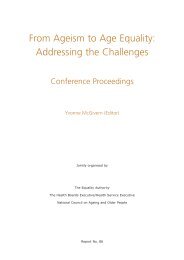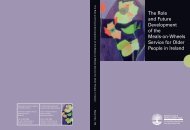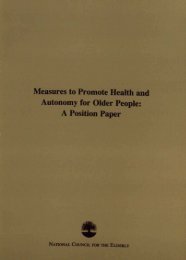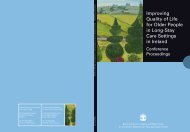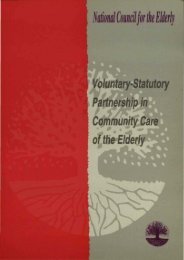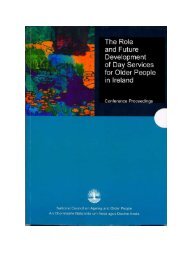Improving Quality of Life for Older People in Long-Stay Care ...
Improving Quality of Life for Older People in Long-Stay Care ...
Improving Quality of Life for Older People in Long-Stay Care ...
- No tags were found...
You also want an ePaper? Increase the reach of your titles
YUMPU automatically turns print PDFs into web optimized ePapers that Google loves.
This chapter provides justification <strong>for</strong> both the quantitative and qualitativeapproaches used <strong>in</strong> the study, as well as <strong>for</strong> the quality <strong>of</strong> life frameworks used toorganise the collection <strong>of</strong> data from the survey and <strong>in</strong>terviews. Chapter Five reportson policy and practice issues with regard to quality issues <strong>in</strong> long-stay care fromthe viewpo<strong>in</strong>t <strong>of</strong> nurse managers. The focus groups <strong>of</strong> nurse managers provided avaluable <strong>in</strong>sight <strong>in</strong>to current th<strong>in</strong>k<strong>in</strong>g on quality <strong>of</strong> life among staff <strong>in</strong> residential caresett<strong>in</strong>gs and helped to <strong>in</strong><strong>for</strong>m subsequent data collection <strong>in</strong> these sett<strong>in</strong>gs. Thef<strong>in</strong>d<strong>in</strong>gs from the survey questionnaire are presented <strong>in</strong> Chapter Six. A number <strong>of</strong>different dimensions are covered <strong>in</strong>clud<strong>in</strong>g: beds, residents, dependency, staff<strong>in</strong>g,services, facilities, activities, care environment and physical environment. Whereverpossible, a comparison is made with previous work by O’Connor et al. (1986) on thequality <strong>of</strong> life <strong>in</strong> private and voluntary nurs<strong>in</strong>g homes.Chapter Seven provides detailed descriptions <strong>of</strong> the study sites used to collectqualitative <strong>in</strong><strong>for</strong>mation from residents and staff on their perceptions <strong>of</strong> factors thatcontribute to older people’s quality <strong>of</strong> life <strong>in</strong> long-stay care. This is followed <strong>in</strong> ChapterEight by the first <strong>of</strong> four chapters on qualitative aspects <strong>of</strong> quality <strong>of</strong> life <strong>in</strong> long-staycare. This chapter exam<strong>in</strong>es the care environment and the ethos <strong>of</strong> care, both <strong>of</strong>which have a huge <strong>in</strong>fluence on the ability <strong>of</strong> residents to live life to the full with<strong>in</strong>an <strong>in</strong>stitutional sett<strong>in</strong>g. A number <strong>of</strong> <strong>in</strong>terrelated issues are explored <strong>in</strong>clud<strong>in</strong>g:autonomy and freedom, choice, and the opportunity to shape the pattern <strong>of</strong> dailyliv<strong>in</strong>g. Chapter N<strong>in</strong>e exam<strong>in</strong>es the extent to which personal identity can be ma<strong>in</strong>ta<strong>in</strong>ed<strong>in</strong> long-stay care. Identity emerges as a lead<strong>in</strong>g issue <strong>in</strong> respect <strong>of</strong> quality <strong>of</strong> life<strong>in</strong> long-stay care <strong>in</strong> Ireland; particularly whether the resident’s own sense <strong>of</strong> selfrema<strong>in</strong>s <strong>in</strong>tact follow<strong>in</strong>g admission and prolonged stay <strong>in</strong> a long-stay facility. Identityis, <strong>of</strong> course, multifaceted and <strong>in</strong>corporates many dimensions, the most important<strong>of</strong> which will be considered <strong>in</strong> this chapter <strong>in</strong>clud<strong>in</strong>g: a sense <strong>of</strong> well-be<strong>in</strong>g, attitudeand outlook, self-expression, spirituality, appearance and privacy.37Connectedness issues are explored <strong>in</strong> Chapter Ten; relationships are important<strong>in</strong> determ<strong>in</strong><strong>in</strong>g quality <strong>of</strong> life <strong>in</strong> long-stay sett<strong>in</strong>gs and mov<strong>in</strong>g <strong>in</strong>to a long-stay facilitymay enhance or dim<strong>in</strong>ish the potential set <strong>of</strong> connections and relationships withother people, <strong>in</strong>clud<strong>in</strong>g family and friends. The chapter explores <strong>in</strong>ternal resident<strong>in</strong>teractions, companionship, family relationships, <strong>in</strong>tergenerational contacts, andgeneral l<strong>in</strong>ks between the community and the residential facility. Mean<strong>in</strong>gful andpurposeful activities are also important <strong>for</strong> quality <strong>of</strong> life <strong>in</strong> long-stay sett<strong>in</strong>gs andthese are exam<strong>in</strong>ed <strong>in</strong> Chapter Eleven. <strong>People</strong>’s preferences are unlikely to alteronce they enter long-stay care, given that they have been <strong>for</strong>med and shapedover a lifetime. It is important, there<strong>for</strong>e, that residents are given the opportunityto pursue <strong>in</strong>terests and activities that they have enjoyed all <strong>of</strong> their life, as well asthe opportunity to participate (voluntarily) <strong>in</strong> new activities <strong>of</strong>fered by the facility.







